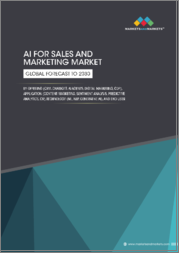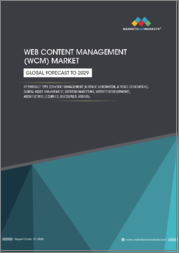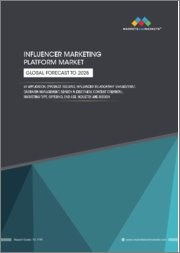
|
시장보고서
상품코드
1574000
세계의 컨텐츠 마케팅 시장 : 채널 유형별, 비즈니스 유형별, 컨텐츠 유형별, 산업 용도별, 고객 유형별, 컨텐츠 포맷별, 목적별 예측(2025-2030년)Content Marketing Market by Channel Type (Earned Media, Owned Media, Paid Media), Business Type (B2B, B2C), Content Type, Industry Application, Customer Type, Content Format, Purpose - Global Forecast 2025-2030 |
||||||
컨텐츠 마케팅 시장은 2023년에 213억 4,000만 달러로 평가되었고, 2024년에는 261억 1,000만 달러에 이를 것으로 예측되며, 복합 연간 성장률(CAGR) 25.76%로 성장하여, 2030년에는 1,062억 3,000만 달러가 될 것으로 예측됩니다.
컨텐츠 마케팅은 명확하게 정의된 잠재고객을 유치하고 유지하며 궁극적으로 수익성 있는 고객 행동을 촉진하기 위해 가치 있고 관련성 있고 일관된 컨텐츠를 만들고 전달합니다. 에 초점을 맞춘 전략적 접근입니다. 그 필요성은 소비자 행동이 매력적이고 밀착성이 없는 정보로 이동하고 있기 때문에 기업은 컨텐츠 마케팅을 활용하여 브랜드 인지도, 신뢰성, 충성도를 높이고 있습니다. 컨텐츠 마케팅의 용도는 소매, 헬스케어, 금융, 기술 등 다양한 산업에 걸쳐 있으며, 최종 용도는 고객 참여, 교육 및 전환 프로세스 강화에 중점을 둡니다. 시장 인사이트에 따르면 디지털 보급, 스마트폰 사용률 증가, 개인화된 컨텐츠 배포를 위한 AI 도구 통합의 영향으로 큰 성장이 보입니다. 또한 비디오 컨텐츠, 팟캐스트 및 대화형 형식에 대한 추세가 유리한 기회를 제공합니다. 기업은 TikTok 및 YouTube와 같은 플랫폼을 타겟으로 하는 민첩한 컨텐츠 제작에 투자함으로써 이를 활용할 수 있습니다. 그러나 컨텐츠 포화, 알고리즘의 급속한 변화, 효과적인 ROI 측정의 어려움 등의 과제는 여전히 남아 있으며 시장 성장에 영향을 미치고 있습니다.세련된 애널리틱스를 실적 지표에 도입하고 스토리텔링을 통해 시청자와의 진정한 연결을 육성함으로써 혁신적인 분야는 정밀한 타겟팅을 위한 데이터 분석 활용, 머신러닝 알고리즘에 의한 적응 컨텐츠, 가상현실 및 증강현실 경험과 같은 미개척 틈새 시장으로의 확대가 중심입니다. 체험의 창출이라는 장점도 있습니다. 소비자의 인사이트과 행동에 대한 조사는 컨텐츠 마케팅 노력의 관련성과 영향력을 강화하고 매우 중요합니다. 활용하다 이를 위해서는 지속적인 적응과 창의성이 요구되고 있습니다. 속에서 지속적인 성장을 실현할 수 있습니다.
| 주요 시장 통계 | |
|---|---|
| 기준년(2023) | 213억 4,000만 달러 |
| 예측년(2024) | 261억 1,000만 달러 |
| 예측년(2030) | 1,062억 3,000만 달러 |
| 복합 연간 성장률(CAGR)(%) | 25.76% |
시장 역학 : 빠르게 진화하는 컨텐츠 마케팅 시장의 주요 시장 인사이트 공개
컨텐츠 마케팅 시장은 수요 및 공급의 역동적 인 상호 작용에 의해 변모하고 있습니다. 이러한 시장 역학의 진화를 이해함으로써 기업은 충분한 정보를 바탕으로 투자결정, 전략적 결정 정밀화, 새로운 비즈니스 기회 획득에 대비할 수 있습니다. 이러한 동향을 종합적으로 파악함으로써 기업은 정치적, 지리적, 기술적, 사회적, 경제적 영역에 걸친 다양한 리스크를 경감할 수 있을 뿐만 아니라, 소비자 행동과 그것이 제조 비용 또는 구매 동향에 미치는 영향을보다 명확하게 이해할 수 있습니다.
- 시장 성장 촉진요인
- 마케팅 예산과 컨텐츠 마케팅 이니셔티브에 대한 지출에 영향을 미치는 경제 변동
- 컨텐츠의 신뢰성과 투명성에 대한 소비자의 의식과 요구 증가
- 공동 제작 컨텐츠에 있어서의 브랜드와 컨텐츠 크리에이터의 콜라보레이션 증가
- 컨텐츠 소비 패턴 및 마케팅 전략에 대한 세계 이벤트의 영향
- 시장 성장 억제요인
- 다양한 플랫폼에서의 컨텐츠 제작에 있어서, 일관된 품질과 독창성을 확보하기 위해서는 많은 자원이 필요
- 급속히 진화하는 기술 동향에 끊임없는 적응이 필요하고, 운용 비용을 밀어 올린다
- 시장 기회
- 소비자의 참여와 전환을 촉진하는 맞춤형 컨텐츠 마케팅 전략의 중요성 증가
- 마케팅의 컨텐츠 작성, 배포, 분석을 최적화하기 위한 AI를 활용한 툴과 기술의 확대
- 컨텐츠 마케팅에서 브랜드의 신뢰성과 도달범위를 강화하기 위한 사용자 생성 컨텐츠와 인플루언서와의 파트너십 활용
- 시장의 과제
- 경쟁 강화와 컨텐츠 포화로 인해 브랜드가 온라인에서 눈에 띄기 어려워지고 있습니다.
- 자원의 제약 속에서 일관된 고품질의 컨텐츠 제작 파이프라인을 유지하는 과제
Porter's Five Forces : 컨텐츠 마케팅 시장을 탐색하는 전략 도구
Porter's Five Forces Framework는 시장 상황경쟁 구도를 이해하는 중요한 도구입니다. Porter's Five Forces Framework는 기업의 경쟁력을 평가하고 전략적 기회를 탐구하는 명확한 기술을 제공합니다. 이 프레임워크는 기업이 시장 내 세력도를 평가하고 신규 사업의 수익성을 결정하는 데 도움이 됩니다. 이러한 인사이트을 통해 기업은 자사의 강점을 활용하고, 약점을 해결하고, 잠재적인 과제를 피할 수 있으며, 보다 강인한 시장에서의 포지셔닝을 보장할 수 있습니다.
PESTLE 분석 : 컨텐츠 마케팅 시장에서 외부 영향을 파악
외부 거시적 환경 요인은 컨텐츠 마케팅 시장의 성과 역학을 형성하는데 매우 중요한 역할을 합니다. 정치적, 경제적, 사회적, 기술적, 법적, 환경적 요인 분석은 이러한 영향을 탐색하는 데 필요한 정보를 제공합니다. PESTLE 요인을 조사함으로써 기업은 잠재적인 위험과 기회를 더 잘 이해할 수 있습니다. 이 분석을 통해 기업은 규제, 소비자 선호, 경제 동향의 변화를 예측하고 앞으로 예상되는 적극적인 의사 결정을 할 준비를 할 수 있습니다.
시장 점유율 분석 컨텐츠 마케팅 시장에서 경쟁 구도 파악
컨텐츠 마케팅 시장의 상세한 시장 점유율 분석을 통해 공급업체의 성과를 종합적으로 평가할 수 있습니다. 기업은 수익, 고객 기반, 성장률 등 주요 지표를 비교하여 경쟁 포지셔닝을 밝힐 수 있습니다. 이 분석을 통해 시장 집중, 단편화, 통합 동향을 밝혀내고 벤더들은 경쟁이 치열해지는 가운데 자사의 지위를 높이는 전략적 의사 결정을 내리는 데 필요한 지식을 얻을 수 있습니다.
FPNV 포지셔닝 매트릭스 컨텐츠 마케팅 시장에서 공급업체의 성능 평가
FPNV 포지셔닝 매트릭스는 컨텐츠 마케팅 시장에서 공급업체를 평가하는 중요한 도구입니다. 이 행렬을 통해 비즈니스 조직은 공급업체의 비즈니스 전략과 제품 만족도를 기준으로 평가하여 목표에 맞는 충분한 정보를 바탕으로 의사 결정을 내릴 수 있습니다. 네 가지 사분면을 통해 공급업체를 명확하고 정확하게 세분화하여 전략 목표에 가장 적합한 파트너 및 솔루션을 파악할 수 있습니다.
전략 분석 및 추천 컨텐츠 마케팅 시장에서 성공을 위한 길을 그리기
컨텐츠 마케팅 시장의 전략 분석은 시장에서의 존재를 강화하려는 기업에게 필수적입니다. 주요 자원, 능력 및 성과 지표를 검토함으로써 기업은 성장 기회를 파악하고 개선을 위해 노력할 수 있습니다. 이러한 접근 방식을 통해 경쟁 구도에서 과제를 극복하고 새로운 비즈니스 기회를 활용하여 장기적인 성공을 거둘 수 있는 체제를 구축할 수 있습니다.
이 보고서는 주요 관심 분야를 포괄하는 시장의 종합적인 분석을 제공합니다.
1. 시장 침투 : 현재 시장 환경의 상세한 검토, 주요 기업의 광범위한 데이터, 시장 도달범위 및 전반적인 영향력 평가.
2. 시장 개척도 : 신흥 시장의 성장 기회를 파악하고 기존 분야의 확장 가능성을 평가하며 미래 성장을 위한 전략적 로드맵을 제공합니다.
3. 시장 다양화 : 최근 제품 출시, 미개척 지역, 업계의 주요 진보, 시장을 형성하는 전략적 투자를 분석합니다.
4. 경쟁 평가 및 정보 : 경쟁 구도를 철저히 분석하여 시장 점유율, 사업 전략, 제품 포트폴리오, 인증, 규제 당국 승인, 특허 동향, 주요 기업의 기술 진보 등을 검증합니다.
5. 제품 개발 및 혁신 : 미래 시장 성장을 가속할 것으로 예상되는 최첨단 기술, R&D 활동, 제품 혁신을 강조합니다.
또한 이해관계자가 충분한 정보를 얻고 의사결정을 할 수 있도록 중요한 질문에 대답하고 있습니다.
1. 현재 시장 규모와 향후 성장 예측은?
2. 최고의 투자 기회를 제공하는 제품, 부문 및 지역은 어디입니까?
3. 시장을 형성하는 주요 기술 동향과 규제의 영향은?
4. 주요 벤더의 시장 점유율과 경쟁 포지션은?
5. 벤더 시장 진입, 철수 전략의 원동력이 되는 수익원과 전략적 기회는 무엇인가?
목차
제1장 서문
제2장 조사 방법
제3장 주요 요약
제4장 시장 개요
제5장 시장 인사이트
- 시장 역학
- 성장 촉진요인
- 마케팅 예산과 컨텐츠 마케팅 이니셔티브에 대한 지출에 영향을 미치는 경제 변화
- 컨텐츠의 신뢰성과 투명성에 대한 소비자의 의식과 수요 증가
- 공동 제작 컨텐츠를 위한 브랜드와 컨텐츠 크리에이터의 콜라보레이션 강화
- 세계의 큰 이벤트가 컨텐츠의 소비 패턴과 마케팅 전략에 미치는 영향
- 억제요인
- 다양한 플랫폼에서의 컨텐츠 제작에 있어서 일관된 품질과 독창성을 확보하기 위해서는 많은 자원이 필요합니다.
- 급속하게 진화하는 기술 동향, 지속적인 적응이 필요해, 운용 코스트가 상승합니다.
- 기회
- 소비자의 참여와 전환을 촉진하기 위한 개인화된 컨텐츠 마케팅 전략의 중요성이 높아지고 있습니다
- 마케팅의 컨텐츠 작성, 배포, 분석을 최적화하기 위한 AI를 활용한 툴과 기술의 확장
- 유저 생성 컨텐츠와 인플루언서와의 파트너십을 활용해 컨텐츠 마케팅에 있어서의 브랜드의 신뢰성과 리치를 강화합니다.
- 과제
- 경쟁의 격화와 컨텐츠의 포화에 의해 브랜드가 온라인으로 눈에 띄는 것이 어려워지고 있다
- 자원의 제약이 있는 가운데, 일관성이 있는 고품질의 컨텐츠 제작 파이프라인을 유지하는 과제
- 성장 촉진요인
- 시장 세분화 분석
- Porter's Five Forces 분석
- PESTEL 분석
- 정치적
- 경제
- 사교
- 기술적
- 법률상
- 환경
제6장 컨텐츠 마케팅 시장 : 채널 유형별
- 언드미디어
- 게스트 블로그
- 인플루언서의 언급
- 미디어 보도
- 홍보
- 사용자 생성 컨텐츠
- 소유 미디어
- 블로그 컨텐츠
- 메일 뉴스레터
- 모바일 앱 컨텐츠
- 팟캐스트
- 소셜 미디어 컨텐츠
- 웨비나
- 웹사이트 컨텐츠
- 유료 미디어
- 디스플레이 광고
- 독감 마케팅
- 클릭 과금형 광고
- 소셜 미디어 광고
- 스폰서 컨텐츠
제7장 컨텐츠 마케팅 시장 : 비즈니스 유형별
- 기업용
- 엔터프라이즈 컨텐츠 마케팅
- 전문 서비스 컨텐츠 마케팅
- 중소기업 컨텐츠 마케팅
- B2C
- 소비자 서비스 컨텐츠 마케팅
- 전자상거래 컨텐츠 마케팅
- 소매업 컨텐츠 마케팅
제8장 컨텐츠 마케팅 시장 : 컨텐츠 유형별
- 인터랙티브 컨텐츠
- 콘테스트
- 설문조사
- 퀴즈
- 조사
- 텍스트 컨텐츠
- 기사
- 블로그 게시물
- 전자서적
- 백서
- 비주얼 컨텐츠
- 이미지
- 인포그래픽
- 프레젠테이션
- 비디오
제9장 컨텐츠 마케팅 시장 : 산업 용도별
- 교육
- 교육기관의 교육 컨텐츠 마케팅
- 온라인 교육 컨텐츠 마케팅
- 금융
- 은행 업무 컨텐츠 마케팅
- 보험 컨텐츠 마케팅
- 투자 컨텐츠 마케팅
- 헬스케어
- 건강 서비스 컨텐츠 마케팅
- 의료기기 컨텐츠 마케팅
- 의약품 컨텐츠 마케팅
- 기술
- 하드웨어 컨텐츠 마케팅
- IT 서비스 컨텐츠 마케팅
- 소프트웨어 컨텐츠 마케팅
제10장 컨텐츠 마케팅 시장 : 고객 유형별
- 고객 충성도
- 고객유지
- 신규 고객 획득
제11장 컨텐츠 마케팅 시장 : 컨텐츠 포맷별
- 롱폼 컨텐츠
- 숏폼 컨텐츠
제12장 컨텐츠 마케팅 시장 : 목적별
- 브랜드 인지도
- 고객교육
- 고객 참여
- 리드 제너레이션
제13장 아메리카 컨텐츠 마케팅 시장
- 아르헨티나
- 브라질
- 캐나다
- 멕시코
- 미국
제14장 아시아태평양 컨텐츠 마케팅 시장
- 호주
- 중국
- 인도
- 인도네시아
- 일본
- 말레이시아
- 필리핀
- 싱가포르
- 한국
- 대만
- 태국
- 베트남
제15장 유럽, 중동 및 아프리카 컨텐츠 마케팅 시장
- 덴마크
- 이집트
- 핀란드
- 프랑스
- 독일
- 이스라엘
- 이탈리아
- 네덜란드
- 나이지리아
- 노르웨이
- 폴란드
- 카타르
- 러시아
- 사우디아라비아
- 남아프리카
- 스페인
- 스웨덴
- 스위스
- 터키
- 아랍에미리트(UAE)
- 영국
제16장 경쟁 구도
- 시장 점유율 분석(2023년)
- FPNV 포지셔닝 매트릭스(2023년)
- 경쟁 시나리오 분석
- 전략 분석과 제안
The Content Marketing Market was valued at USD 21.34 billion in 2023, expected to reach USD 26.11 billion in 2024, and is projected to grow at a CAGR of 25.76%, to USD 106.23 billion by 2030.
Content marketing is a strategic approach focused on creating and distributing valuable, relevant, and consistent content to attract and retain a clearly defined audience, ultimately driving profitable customer action. Its necessity stems from the shift in consumer behavior towards engaging and non-intrusive information, with companies leveraging content marketing to build brand awareness, credibility, and loyalty. The application of content marketing spans across diverse industries, including retail, healthcare, finance, and technology, with end-use focused on enhancing customer engagement, education, and conversion processes. Market insights reveal significant growth influenced by digital proliferation, increased smartphone usage, and the integration of AI tools for personalized content delivery. Additionally, the trend towards video content, podcasts, and interactive formats presents lucrative opportunities; firms can capitalize on these by investing in agile content creation, targeting platforms like TikTok and YouTube. However, challenges such as content saturation, rapidly changing algorithms, and difficulties in effectively measuring ROI persist, impacting market growth. Overcome these by deploying sophisticated analytics for performance metrics and fostering genuine audience connection through storytelling. Innovation areas are centered on utilizing data analytics for precision targeting, adaptive content powered by machine learning algorithms, and expanding into untapped niches, such as virtual and augmented reality experiences. Despite being predominantly digital, content marketing also benefits from integration with offline channels, creating a seamless omnichannel experience. Research into consumer insights and behavior remains pivotal, enhancing the relevancy and impact of content marketing efforts. The content marketing sector is dynamic and competitive, requiring continuous adaptation and creativity to harness market potential. With technology at its core, businesses focused on enriching audience engagement and delivering value-driven content can maintain a competitive edge, ensuring sustainable growth in the evolving market landscape.
| KEY MARKET STATISTICS | |
|---|---|
| Base Year [2023] | USD 21.34 billion |
| Estimated Year [2024] | USD 26.11 billion |
| Forecast Year [2030] | USD 106.23 billion |
| CAGR (%) | 25.76% |
Market Dynamics: Unveiling Key Market Insights in the Rapidly Evolving Content Marketing Market
The Content Marketing Market is undergoing transformative changes driven by a dynamic interplay of supply and demand factors. Understanding these evolving market dynamics prepares business organizations to make informed investment decisions, refine strategic decisions, and seize new opportunities. By gaining a comprehensive view of these trends, business organizations can mitigate various risks across political, geographic, technical, social, and economic domains while also gaining a clearer understanding of consumer behavior and its impact on manufacturing costs and purchasing trends.
- Market Drivers
- Economic shifts influencing marketing budgets and spending on content marketing initiatives
- Growing consumer awareness and demand for authenticity and transparency in content
- Increasing collaboration between brands and content creators for co-produced content
- Impact of major global events on content consumption patterns and marketing strategies
- Market Restraints
- Ensuring consistent quality and originality in content creation across various platforms is resource-intensive
- Rapidly evolving technological trends necessitate constant adaptation, driving up operational costs
- Market Opportunities
- The growing significance of personalized content marketing strategies in driving consumer engagement and conversion
- Expansion of AI-powered tools and technologies for optimizing content creation, distribution, and analytics in marketing
- Leveraging user-generated content and influencer partnerships to enhance brand authenticity and reach in content marketing
- Market Challenges
- The increasing competition and content saturation making it difficult for brands to stand out online
- The challenge of maintaining a consistent and high-quality content production pipeline amid resource constraints
Porter's Five Forces: A Strategic Tool for Navigating the Content Marketing Market
Porter's five forces framework is a critical tool for understanding the competitive landscape of the Content Marketing Market. It offers business organizations with a clear methodology for evaluating their competitive positioning and exploring strategic opportunities. This framework helps businesses assess the power dynamics within the market and determine the profitability of new ventures. With these insights, business organizations can leverage their strengths, address weaknesses, and avoid potential challenges, ensuring a more resilient market positioning.
PESTLE Analysis: Navigating External Influences in the Content Marketing Market
External macro-environmental factors play a pivotal role in shaping the performance dynamics of the Content Marketing Market. Political, Economic, Social, Technological, Legal, and Environmental factors analysis provides the necessary information to navigate these influences. By examining PESTLE factors, businesses can better understand potential risks and opportunities. This analysis enables business organizations to anticipate changes in regulations, consumer preferences, and economic trends, ensuring they are prepared to make proactive, forward-thinking decisions.
Market Share Analysis: Understanding the Competitive Landscape in the Content Marketing Market
A detailed market share analysis in the Content Marketing Market provides a comprehensive assessment of vendors' performance. Companies can identify their competitive positioning by comparing key metrics, including revenue, customer base, and growth rates. This analysis highlights market concentration, fragmentation, and trends in consolidation, offering vendors the insights required to make strategic decisions that enhance their position in an increasingly competitive landscape.
FPNV Positioning Matrix: Evaluating Vendors' Performance in the Content Marketing Market
The Forefront, Pathfinder, Niche, Vital (FPNV) Positioning Matrix is a critical tool for evaluating vendors within the Content Marketing Market. This matrix enables business organizations to make well-informed decisions that align with their goals by assessing vendors based on their business strategy and product satisfaction. The four quadrants provide a clear and precise segmentation of vendors, helping users identify the right partners and solutions that best fit their strategic objectives.
Strategy Analysis & Recommendation: Charting a Path to Success in the Content Marketing Market
A strategic analysis of the Content Marketing Market is essential for businesses looking to strengthen their global market presence. By reviewing key resources, capabilities, and performance indicators, business organizations can identify growth opportunities and work toward improvement. This approach helps businesses navigate challenges in the competitive landscape and ensures they are well-positioned to capitalize on newer opportunities and drive long-term success.
Key Company Profiles
The report delves into recent significant developments in the Content Marketing Market, highlighting leading vendors and their innovative profiles. These include Ahrefs, Buffer, BuzzSumo, ClearVoice, Contently, ContentStudio, CoSchedule, Eloqua, Hootsuite, HubSpot, Kapost, Marketo, Moz, NewsCred, Outbrain, Percolate, SEMrush, Skyword, Sprout Social, and Taboola.
Market Segmentation & Coverage
This research report categorizes the Content Marketing Market to forecast the revenues and analyze trends in each of the following sub-markets:
- Based on Channel Type, market is studied across Earned Media, Owned Media, and Paid Media. The Earned Media is further studied across Guest Blogging, Influencer Mentions, Media Coverage, Public Relations, and User-Generated Content. The Owned Media is further studied across Blog Content, Email Newsletters, Mobile Apps Content, Podcasts, Social Media Content, Webinars, and Website Content. The Paid Media is further studied across Display Advertising, Influencer Marketing, Pay-Per-Click Advertising, Social Media Advertising, and Sponsored Content.
- Based on Business Type, market is studied across B2B and B2C. The B2B is further studied across Enterprise Content Marketing, Professional Services Content Marketing, and Small Business Content Marketing. The B2C is further studied across Consumer Services Content Marketing, E-Commerce Content Marketing, and Retail Content Marketing.
- Based on Content Type, market is studied across Interactive Content, Textual Content, and Visual Content. The Interactive Content is further studied across Contests, Polls, Quizzes, and Surveys. The Textual Content is further studied across Articles, Blog Posts, Ebooks, and Whitepapers. The Visual Content is further studied across Images, Infographics, Presentations, and Videos.
- Based on Industry Application, market is studied across Education, Finance, Healthcare, and Technology. The Education is further studied across Institutional Education Content Marketing and Online Education Content Marketing. The Finance is further studied across Banking Content Marketing, Insurance Content Marketing, and Investment Content Marketing. The Healthcare is further studied across Health Services Content Marketing, Medical Devices Content Marketing, and Pharmaceutical Content Marketing. The Technology is further studied across Hardware Content Marketing, IT Services Content Marketing, and Software Content Marketing.
- Based on Customer Type, market is studied across Customer Loyalty, Customer Retention, and New Customer Acquisition.
- Based on Content Format, market is studied across Long-Form Content and Short-Form Content.
- Based on Purpose, market is studied across Brand Awareness, Customer Education, Customer Engagement, and Lead Generation.
- Based on Region, market is studied across Americas, Asia-Pacific, and Europe, Middle East & Africa. The Americas is further studied across Argentina, Brazil, Canada, Mexico, and United States. The United States is further studied across California, Florida, Illinois, New York, Ohio, Pennsylvania, and Texas. The Asia-Pacific is further studied across Australia, China, India, Indonesia, Japan, Malaysia, Philippines, Singapore, South Korea, Taiwan, Thailand, and Vietnam. The Europe, Middle East & Africa is further studied across Denmark, Egypt, Finland, France, Germany, Israel, Italy, Netherlands, Nigeria, Norway, Poland, Qatar, Russia, Saudi Arabia, South Africa, Spain, Sweden, Switzerland, Turkey, United Arab Emirates, and United Kingdom.
The report offers a comprehensive analysis of the market, covering key focus areas:
1. Market Penetration: A detailed review of the current market environment, including extensive data from top industry players, evaluating their market reach and overall influence.
2. Market Development: Identifies growth opportunities in emerging markets and assesses expansion potential in established sectors, providing a strategic roadmap for future growth.
3. Market Diversification: Analyzes recent product launches, untapped geographic regions, major industry advancements, and strategic investments reshaping the market.
4. Competitive Assessment & Intelligence: Provides a thorough analysis of the competitive landscape, examining market share, business strategies, product portfolios, certifications, regulatory approvals, patent trends, and technological advancements of key players.
5. Product Development & Innovation: Highlights cutting-edge technologies, R&D activities, and product innovations expected to drive future market growth.
The report also answers critical questions to aid stakeholders in making informed decisions:
1. What is the current market size, and what is the forecasted growth?
2. Which products, segments, and regions offer the best investment opportunities?
3. What are the key technology trends and regulatory influences shaping the market?
4. How do leading vendors rank in terms of market share and competitive positioning?
5. What revenue sources and strategic opportunities drive vendors' market entry or exit strategies?
Table of Contents
1. Preface
- 1.1. Objectives of the Study
- 1.2. Market Segmentation & Coverage
- 1.3. Years Considered for the Study
- 1.4. Currency & Pricing
- 1.5. Language
- 1.6. Stakeholders
2. Research Methodology
- 2.1. Define: Research Objective
- 2.2. Determine: Research Design
- 2.3. Prepare: Research Instrument
- 2.4. Collect: Data Source
- 2.5. Analyze: Data Interpretation
- 2.6. Formulate: Data Verification
- 2.7. Publish: Research Report
- 2.8. Repeat: Report Update
3. Executive Summary
4. Market Overview
5. Market Insights
- 5.1. Market Dynamics
- 5.1.1. Drivers
- 5.1.1.1. Economic shifts influencing marketing budgets and spending on content marketing initiatives
- 5.1.1.2. Growing consumer awareness and demand for authenticity and transparency in content
- 5.1.1.3. Increasing collaboration between brands and content creators for co-produced content
- 5.1.1.4. Impact of major global events on content consumption patterns and marketing strategies
- 5.1.2. Restraints
- 5.1.2.1. Ensuring consistent quality and originality in content creation across various platforms is resource-intensive
- 5.1.2.2. Rapidly evolving technological trends necessitate constant adaptation, driving up operational costs
- 5.1.3. Opportunities
- 5.1.3.1. The growing significance of personalized content marketing strategies in driving consumer engagement and conversion
- 5.1.3.2. Expansion of AI-powered tools and technologies for optimizing content creation, distribution, and analytics in marketing
- 5.1.3.3. Leveraging user-generated content and influencer partnerships to enhance brand authenticity and reach in content marketing
- 5.1.4. Challenges
- 5.1.4.1. The increasing competition and content saturation making it difficult for brands to stand out online
- 5.1.4.2. The challenge of maintaining a consistent and high-quality content production pipeline amid resource constraints
- 5.1.1. Drivers
- 5.2. Market Segmentation Analysis
- 5.3. Porter's Five Forces Analysis
- 5.3.1. Threat of New Entrants
- 5.3.2. Threat of Substitutes
- 5.3.3. Bargaining Power of Customers
- 5.3.4. Bargaining Power of Suppliers
- 5.3.5. Industry Rivalry
- 5.4. PESTLE Analysis
- 5.4.1. Political
- 5.4.2. Economic
- 5.4.3. Social
- 5.4.4. Technological
- 5.4.5. Legal
- 5.4.6. Environmental
6. Content Marketing Market, by Channel Type
- 6.1. Introduction
- 6.2. Earned Media
- 6.2.1. Guest Blogging
- 6.2.2. Influencer Mentions
- 6.2.3. Media Coverage
- 6.2.4. Public Relations
- 6.2.5. User-Generated Content
- 6.3. Owned Media
- 6.3.1. Blog Content
- 6.3.2. Email Newsletters
- 6.3.3. Mobile Apps Content
- 6.3.4. Podcasts
- 6.3.5. Social Media Content
- 6.3.6. Webinars
- 6.3.7. Website Content
- 6.4. Paid Media
- 6.4.1. Display Advertising
- 6.4.2. Influencer Marketing
- 6.4.3. Pay-Per-Click Advertising
- 6.4.4. Social Media Advertising
- 6.4.5. Sponsored Content
7. Content Marketing Market, by Business Type
- 7.1. Introduction
- 7.2. B2B
- 7.2.1. Enterprise Content Marketing
- 7.2.2. Professional Services Content Marketing
- 7.2.3. Small Business Content Marketing
- 7.3. B2C
- 7.3.1. Consumer Services Content Marketing
- 7.3.2. E-Commerce Content Marketing
- 7.3.3. Retail Content Marketing
8. Content Marketing Market, by Content Type
- 8.1. Introduction
- 8.2. Interactive Content
- 8.2.1. Contests
- 8.2.2. Polls
- 8.2.3. Quizzes
- 8.2.4. Surveys
- 8.3. Textual Content
- 8.3.1. Articles
- 8.3.2. Blog Posts
- 8.3.3. Ebooks
- 8.3.4. Whitepapers
- 8.4. Visual Content
- 8.4.1. Images
- 8.4.2. Infographics
- 8.4.3. Presentations
- 8.4.4. Videos
9. Content Marketing Market, by Industry Application
- 9.1. Introduction
- 9.2. Education
- 9.2.1. Institutional Education Content Marketing
- 9.2.2. Online Education Content Marketing
- 9.3. Finance
- 9.3.1. Banking Content Marketing
- 9.3.2. Insurance Content Marketing
- 9.3.3. Investment Content Marketing
- 9.4. Healthcare
- 9.4.1. Health Services Content Marketing
- 9.4.2. Medical Devices Content Marketing
- 9.4.3. Pharmaceutical Content Marketing
- 9.5. Technology
- 9.5.1. Hardware Content Marketing
- 9.5.2. IT Services Content Marketing
- 9.5.3. Software Content Marketing
10. Content Marketing Market, by Customer Type
- 10.1. Introduction
- 10.2. Customer Loyalty
- 10.3. Customer Retention
- 10.4. New Customer Acquisition
11. Content Marketing Market, by Content Format
- 11.1. Introduction
- 11.2. Long-Form Content
- 11.3. Short-Form Content
12. Content Marketing Market, by Purpose
- 12.1. Introduction
- 12.2. Brand Awareness
- 12.3. Customer Education
- 12.4. Customer Engagement
- 12.5. Lead Generation
13. Americas Content Marketing Market
- 13.1. Introduction
- 13.2. Argentina
- 13.3. Brazil
- 13.4. Canada
- 13.5. Mexico
- 13.6. United States
14. Asia-Pacific Content Marketing Market
- 14.1. Introduction
- 14.2. Australia
- 14.3. China
- 14.4. India
- 14.5. Indonesia
- 14.6. Japan
- 14.7. Malaysia
- 14.8. Philippines
- 14.9. Singapore
- 14.10. South Korea
- 14.11. Taiwan
- 14.12. Thailand
- 14.13. Vietnam
15. Europe, Middle East & Africa Content Marketing Market
- 15.1. Introduction
- 15.2. Denmark
- 15.3. Egypt
- 15.4. Finland
- 15.5. France
- 15.6. Germany
- 15.7. Israel
- 15.8. Italy
- 15.9. Netherlands
- 15.10. Nigeria
- 15.11. Norway
- 15.12. Poland
- 15.13. Qatar
- 15.14. Russia
- 15.15. Saudi Arabia
- 15.16. South Africa
- 15.17. Spain
- 15.18. Sweden
- 15.19. Switzerland
- 15.20. Turkey
- 15.21. United Arab Emirates
- 15.22. United Kingdom
16. Competitive Landscape
- 16.1. Market Share Analysis, 2023
- 16.2. FPNV Positioning Matrix, 2023
- 16.3. Competitive Scenario Analysis
- 16.4. Strategy Analysis & Recommendation
Companies Mentioned
- 1. Ahrefs
- 2. Buffer
- 3. BuzzSumo
- 4. ClearVoice
- 5. Contently
- 6. ContentStudio
- 7. CoSchedule
- 8. Eloqua
- 9. Hootsuite
- 10. HubSpot
- 11. Kapost
- 12. Marketo
- 13. Moz
- 14. NewsCred
- 15. Outbrain
- 16. Percolate
- 17. SEMrush
- 18. Skyword
- 19. Sprout Social
- 20. Taboola



















